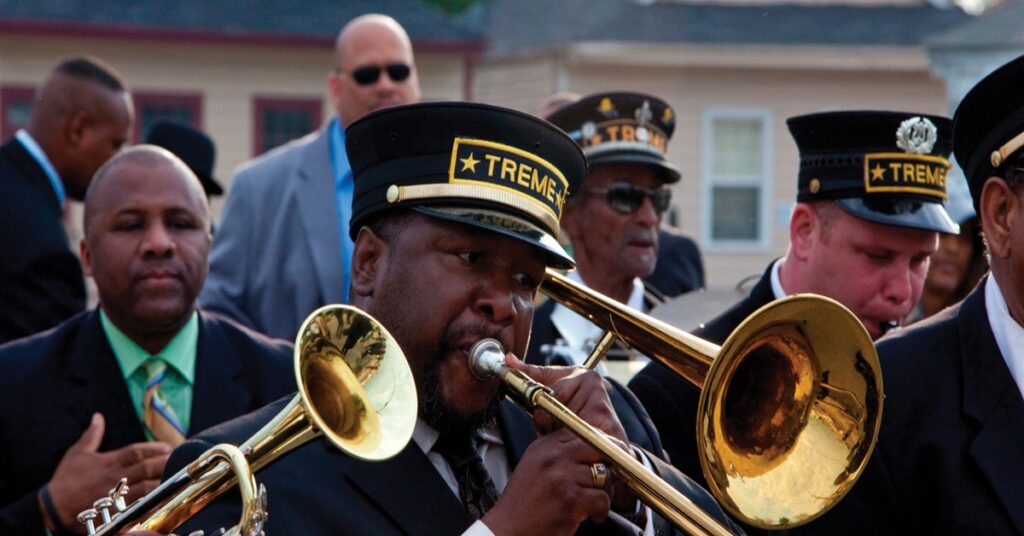
To many, HBO’s Treme, created by The Wire writer David Simon, has to be one of the most boring pieces of television ever. It’s super slow, there’s basically no plot in a dramatic sense, and there’s a whole ton of characters that just are. There are no “blaze of glory” moments, gory violence, or overly graphic sex scenes. No, it’s just a work of television that offers a distinctively intricate and grounded portrayal of New Orleans and its cultural, social, and political complexities. Yet we’re here to discuss exactly why this show is a slow burn worth watching.
Set in New Orleans, Treme opens up three months following Hurricane Katrina’s devastation of New Orleans. However, unlike many portrayals of disaster aftermaths, which often prioritize dramatic visuals and high-stakes scenarios to captivate the audiences, Treme stands out by exploring the long process of recovery in a way we’re not really used to seeing on modern television. Unlike The Wire, to which it’s inevitably compared, Treme apparently has no overarching storyline at the conclusion of which all of its characters would live happily ever after and everything would have been resolved.

Instead, Treme introduces us to its main characters, who seemingly aren’t connected to one another, and documents the struggles they face in overcoming political, bureaucratic, economic, and social roadblocks as they’re trying to rebuild their community after a major disaster. The lack of interconnectedness, paired with the apparent lack of an overarching narrative, provides the audiences with no perceivable reason as to why they’re supposed to care about said characters and their varying struggles in the first place.
But therein lies Treme‘s greatness. The show’s slow pacing, which is one of its defining characteristics, mirrors the slow and often frustrating pace of recovery it explores. The writers’ choice to abandon structured storytelling mimics real life — which rarely conforms to structured narratives, putting the storytelling emphasis on the characters themselves. Treme has, perhaps, one of the richest tapestries of the most diverse characters we’ve ever seen in a television/streaming show, and not just in terms of race but also backgrounds, gender, profession, etc.

Though the main characters are mostly artists, such as a DJ, a violinist, a chef, a trombonist, and a trumpeter (which really plays nice with the identity and spirit of New Orleans), there is also a lawyer, a police officer, a bar owner, a city contractor, and an Indian chief. Each of these characters was given a story of their own, which allowed David Simon and Eric Overmyer to deliver a range of stories about different people going through different things in their personal, professional, and creative lives while being connected to the central idea of “rebuilding” in whatever sense that means for them.
It’s around those stories that another faint and barely noticeable narrative thread takes hold, perhaps the one that writers actually wanted to tell. It’s an under-told story of the political history of New Orleans after Katrina, a story of federal neglect, misconduct by various political figures and officials, and deeply entrenched corruption. It’s a story of a system that has systematically failed those whom it was designed to help and protect.

In fact, both David Simon and Eric Overmyer encyclopedically referenced real events, artists, locales, and political controversies of that time. This also includes criticism of the local, state, and federal governments’ response to Hurricane Katrina, which was a major cause for dispute in 2005. It consisted primarily of condemnations of the mismanagement and lack of preparation in the relief efforts by local and state government in response to Hurricane Katrina and its aftermath — specifically to the delayed response and inaction of those in power during the flooding of New Orleans.
This is what separates Treme from The Wire. Both feature fantastic writing, incredibly sharp characterization, and massive attention to setting and detail. But where The Wire frames those elements into a narrative structured as a cop show, with its weekly and seasonal build-up that often culminate by the season’s end, Treme tells its tale in a much more sophisticated manner. It takes those same elements and frames them within a seemingly slow and mundane post-Katrina recovery process, as experienced by its many characters.

By weaving this story around a cast of spirited New Orleanians and their everyday struggles to rebuild their lives and their community, the writers provided the context to the violence that is often an inevitable result of a broken system in which those we elected to lead and protect us protect nothing else but their own interests. And this is precisely what makes Treme worth watching again: the meticulously crafted underlying story about the political situation regarding post-Katrina New Orleans could potentially extend to the entire nation.
The final episode, however, sends a rather powerful message. After LaDonna’s bar burns down, one of the characters throws a fundraiser, and for a moment, all the characters come together to help her resuscitate her business. This provides one last nod to the power of community and its people, which is ultimately what Treme is all about.







